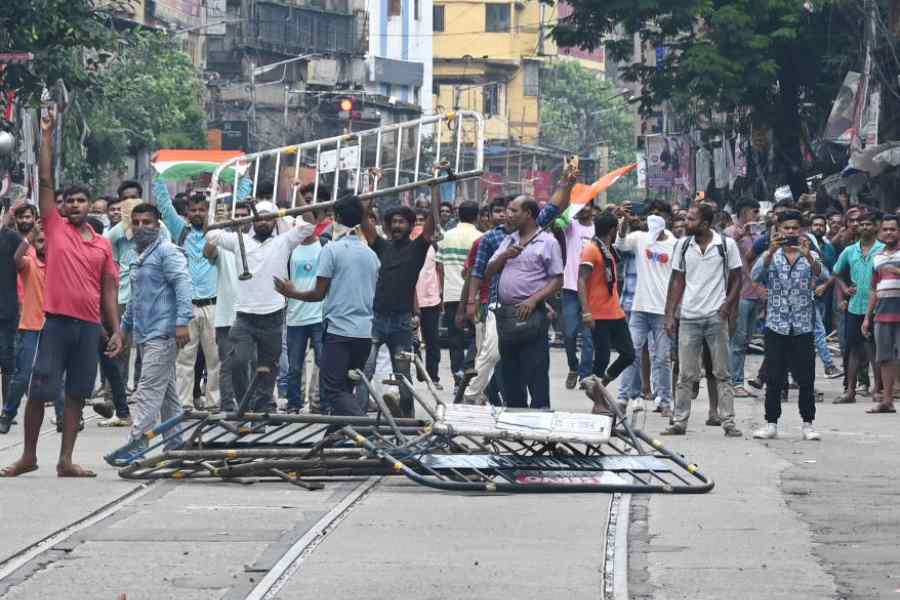Guardrails flying at police along with bricks and bottles. Officers chased, pinned on the road and beaten. Barricades tied with thick wiring and reinforced with sandbags — at some places cemented to the road — dismantled deftly or just ripped apart.
The choicest abuse at the police’s mothers and sisters interspersed with chants of, “We want justice.”
Calcutta’s streets, witness to decades of political violence, would rarely have seen so many skirmishes fought at so many places simultaneously as on Tuesday; the city’s police at one point forced to fire water cannons and tear gas in at least six locations together.
At least 36 police personnel were injured. BJP leader Suvendu Adhikari put the count of injured protesters at 133, who he said included 17 women.
As the protests began rolling around noon, small knots of ordinary women and men seemed to have joined in, protesting the horrific rape and murder of a junior doctor at RG Kar Hospital on August 9.
But as the crowds swelled and barricades that had looked impenetrable for a while began to be expertly breached, a different kind of protester — mostly male — seemed to have taken over.
The rallyists, who had hit the streets under the banner of the Pashchimbanga Chhatra Samaj and Sangrami Joutha Mancha, tore through 10ft-tall barricades or mounted them and attacked the police with bricks, bottles and sticks.

Students? Look again: Vandalising guardrails and mouthing profanities, Nabanna marchers take over MG Road on Tuesday. Many of the middle-aged protesters, who also attacked police and unleashed a rampage on the streets, indentified themselves as “former students” and “parents of students”. Pradip Sanyal
The violence they unleashed threatened to sideline the original cause of the protest: justice for the brutalised young doctor.
Almost all the agitators this newspaper spoke to unequivocally demanded Mamata Banerjee’s resignation as the single point of their “fight for justice”. Some went on to say that the protest was against Mamata’s “appeasement of Muslims”.
Additional director-general of police (south Bengal) Supratim Sarkar said the police had on Monday night made “preventive arrests” of 25 people who carried firearms and bombs and were plotting violence at Tuesday’s rally.
“Had we not made the preventive arrests, the scene today would have been infinitely worse. The police showed extreme restraint today,” Sarkar said.
Over 220 people had been arrested till Tuesday evening on the charges of attacking or abusing the police, damaging public property and setting fire to police vehicles.
ADG (law and order) Manoj Verma said: “The arrests we made were based on specific information and evidence.”
Hundreds of men — and several women — participating in the “students’ rally” were seen hurling bricks and bottles at the police, jumping over barricades and chasing the law-keepers with rods. Some policemen were caught and beaten. At least two officers were chased in Babughat and several others in Howrah. Sarkar said the day’s protesters “can have been anything but not students”.
“We strongly believe that students in Bengal cannot engage in hooliganism like this. Some people tried to fulfil their vested interests in the garb of a students’ movement,” Sarkar said.
“This was a deliberate ploy to instigate the police. But the police did not fall into the trap. The police used force only in places where it had become absolutely necessary. There were repeated announcements through loudhailers to keep the protest peaceful.”
At some places, the police placed cargo containers horizontally on roads to thwart the marchers.
Ten cases have been started suo motu at the Alipore, Hastings, Maidan, Hare Street, Muchipara, Amherst Street, New Market, Burrabazar, Jorasanko and North Port police stations.
The police posted the photographs of many protesters, who had allegedly been seen hurling stones, on the force’s social media handles, seeking help from Calcuttans to identify them.
The first bout of violence was reported from Santragachhi in Howrah where a group, stopped by a multi-layered barricade, first shook the steel hurdles and then wrenched some of the steel rods off to make a passage for themselves. Howrah police replied with water cannons.
A similar technique was used to breach barricades in place after place: Foreshore Road, Howrah Maidan, MG Road, AJC Bose Road, Kazipara, College Square, Howrah Bridge and, finally, Lalbazar Street.
At Howrah Maidan, a few kilometres from Nabanna, protesters threw iron guardrails as missiles targeting the police. One officer was singled out, pinned down on the road and beaten by a mob till his colleagues rescued him.
The officer was later seen leaving the spot, a piece of blood-soaked cloth tied round his head.
On Foreshore Road in Howrah, the mob twisted the iron barricades to continue its march towards Nabanna till the police’s tear gas shells and water cannons beat it back.
Senior police officers said multi-layered barricades had been erected keeping in mind the intelligence they had about the attackers and their plans.
In some places, bamboo stick barriers had been dug into the ground and the spot cemented over, turning them into almost permanent structures that would be difficult to remove. Elsewhere, the police used thick wires to tie the guardrails together and bolstered them with sandbags.
Yet, the ease with which some of the protesters managed to dismantle them suggested they were well versed in the job, senior officers said.
While the marchers breached the barricades at many places, and many tried to dodge the cordon by taking a maze of alleyways to get closer to Nabanna, the police succeeded in keeping the protests at least a kilometre away from the state secretariat.











